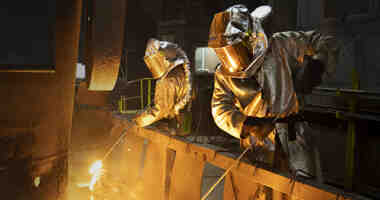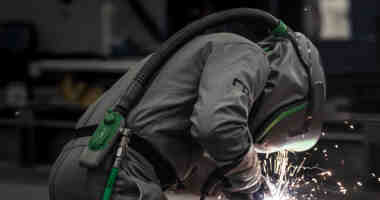
The full effects of respiratory hazards that operators are exposed to often remain unknown until the negative health effects become apparent. When this happens, these are classified as Occupational Lung Diseases.
Industry Challenges
Industrial environments are plagued with hazards. When these are visible, it’s obvious the safety measures and protection that should be used to help mitigate the risk. When it comes to respiratory hazards, a lot of the effects are unknown until it’s too late and it’s only through examining people that have been exposed to the hazard for a number of years before the long term effects present themselves. When this occurs, these are classified as occupational lung diseases which are conditions that are determined to have been made worse due to the materials that a person is exposed to at their workplace.
Industrial applications use a wide range of materials and methods in order to create the product or service they provide. As part of this, incredibly small particles from the materials can become airborne, whether this is from propelling slag, cutting/grinding concrete, welding metals or spraying paint. Whatever the application and material, the issue remains the same. Because the particles are so small, they are easy to breathe in. Depending on the amount that is inhaled, the type of material and the duration of the exposure, these all influence how negatively this will impact the exposed person’s life in both the short and long term.
Common Occupational Lung Diseases include:
Pneumoconiosis – a general term for a class of lung diseases that have caused interstitial fibrosis (scarring of the lungs). This includes diseases such as silicosis, asbestosis, berylliosis, aluminosis, and coal workers pneumoconiosis.
Asthma – a condition where airways may narrow, swell and produce extra mucus making breathing difficult while reducing the amount of oxygen that is breathed in.
Chronic Obstructive Pulmonary Disease (COPD) – is a group of progressive lung diseases that make breathing difficult. Two of the most prevalent in this group are emphysema and chronic bronchitis.
Lung Cancer – a clustering of abnormal cells that form a tumor together. This grows rapidly destroying healthy lung tissue.
Symptoms
Although these occupational lung diseases are all very different in their nature and causation, the estimated 50 million people globally that suffer from occupational lung disease all have very universal symptoms which include:
- Coughing
- Shortness of breath
- Chest pain
- Chest tightness
- Abnormal breathing patterns.
Getting diagnosed
In order to assess if a person has an occupational lung disease, there are a number of questions a doctor will go through first to gather relevant information to form an overview. This may include the history of symptoms, previous employment, contact with materials, workplace safety protocol and completed occupational health history forms.
There are also a number of tests that are used to determine what the condition is and the severity of this. Typically initial X-ray or CT scans are completed and if required, other tests may be completed. These can include pulmonary function tests which help to determine the lungs’ ability to move air in and out, autopsy/biopsy of tissues cells and fluid from the lungs, examination of airways/bronchial activity, and measuring respiratory/gas exchange functions.
The earlier this information is gathered, the better the outcome for the person is likely to be. However, no matter how early detection and diagnosis is, any damage that occurs to the lung tissue is irreversible.
Preventing Occupational Lung Disease
Examining the past is important in understanding how we can do things better in order to protect peoples lives. Sadly, through mistakes and lack of knowledge, exposure risks have been created and we have then been able to study these occurrences and determine what has been the catalyst for these lung diseases. Once we know that a material or way of doing things is dangerous, then we are able to put in place the appropriate measures to control this and keep the person safe.
NIOSH’s hierarchy of controls provides a good basis of methods that should be used to protect workers from being exposed to hazards in their workplace.
Elimination – Physically removing the hazard.
Substitution – Replacing the hazard with an alternative, i.e. using a material that gets the same desired result but does not pose any health risks.
Engineering controls – Isolating the workers from hazards, such as extraction fans.
Administrative controls – Changing the way the work is performed.
Personal Protective Equipment (PPE) – This prevents respiratory hazards from being respired as the user has a line of defense between them and their environment.
By utilizing these measures, Occupational Lung Diseases do not have to occur and industrial workers can go home from work safe each day and live long healthy lives free from the effects of hazardous environments.
Works Cited
Ceders Sinai. (n.d.). Occupational Lung Diseases. Retrieved from Cedars Sinai: https://www.cedars-sinai.org/health-library/diseases-and-conditions/o/occupational-lung-diseases.html
Family Doctor. (n.d.). Occupational Respiratory Disease. Retrieved from Family Doctor: https://familydoctor.org/condition/occupational-respiratory-disease/
Ips Theraeutique Inc. (n.d.). Respiratory. Retrieved from Ips Theraeutique Inc: https://www.ipstherapeutique.com/respiratory/
John Hopkins Medicine. (n.d.). Occupational Lung Diseases. Retrieved from John Hopkins Medicine:
https://www.hopkinsmedicine.org/health/conditions-and-diseases/occupational-lung-diseases
Mayo Clinic. (2020, November 11). Asthma. Retrieved from Mayo Clinic: https://www.mayoclinic.org/diseases-conditions/asthma/symptoms-causes/syc-20369653
Safe Work Australia. (2020, December 2). Occupational lung diseases. Retrieved from Safe Work Australia:
https://www.safeworkaustralia.gov.au/occupational-lung-diseases
Silberstein, N. (2019, December 31). Silicosis: Am I At Risk? Retrieved from Health Day: https://consumer.healthday.com/encyclopedia/work-and-health-41/occupational-health-news-507/silicosis-am-i-at-risk-646683.html



